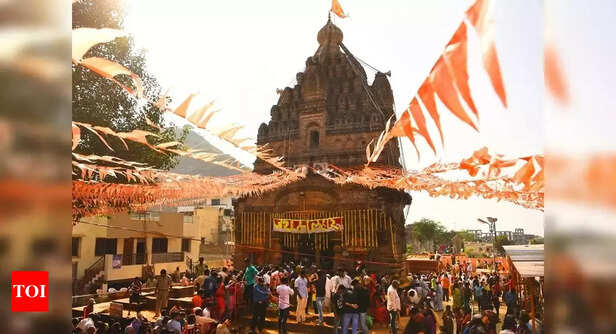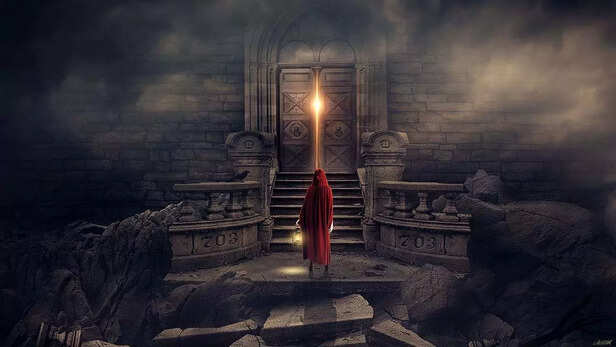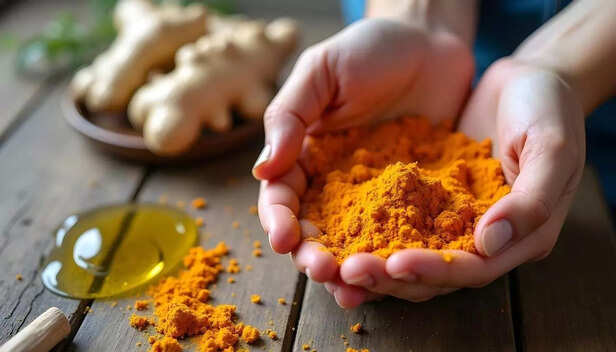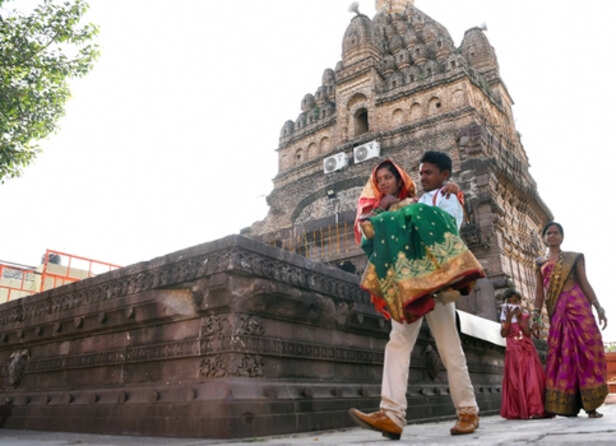Maharashtra’s Khandoba Temple – 450 Steps of Love, Forges Strong Bond
Ankit Gupta | Mar 19, 2025, 11:51 IST
Steps leading to the divine
The Khandoba Temple in Jejuri is indeed famous for its hilltop location, though traditional accounts often cite around 200 steps to the sanctum, with some sources mentioning up to 450 when counting additional pathways or exaggerated folklore. The ritual you describe—husbands carrying their wives up the steps—appears to be a celebrated custom, likely rooted in the deity’s mythology as a powerful warrior and devoted husband to Mhalsa. This act symbolizes not only physical prowess but also marital commitment, aligning with Khandoba’s role as a protector and family deity.
In the rugged hills of Maharashtra, where the sun burns fierce and the air vibrates with devotion, stands a shrine that’s more than stone—it’s a testament to love. The Khandoba Temple in Jejuri, perched atop a windswept hill, isn’t just a pilgrimage site; it’s a stage for one of India’s most stirring rituals. Here, husbands lift their wives onto their shoulders and climb 450 steps, each one a promise, each one bathed in the golden dust of turmeric. This isn’t a quiet prayer whispered in a corner—it’s a loud, sweaty, haldi-smeared declaration of commitment, cheered on by crowds chanting “Yelkot Yelkot Jai Malhar!” to honor Khandoba, the warrior god of the Deccan.
Jejuri, known as “Sonyachi Jejuri” (Golden Jejuri), comes alive during festivals like Champa Shashthi and Somvati Amavasya. The temple’s steps transform into a river of yellow, the air thick with turmeric flung by pilgrims. Couples ascend to seek Khandoba’s blessings—be it for a child, a stronger bond, or a answered vow. Over a thousand people climb daily, drawn by faith and the thrill of this golden challenge. Yet, for those who falter, tradition offers grace: only the first five steps are mandatory—a symbolic start for every heart willing to try. This article takes you up those 450 steps, into the heart of Maharashtra’s Khandoba Temple, where love isn’t just felt—it’s carried, step by gritty step. From ancient legends to the voices of today’s pilgrims, we’ll uncover why this climb remains a living symbol of devotion in India’s soul.

Every step up Jejuri’s hill echoes a story older than the stones beneath. Khandoba, the deity at the heart of this temple, is no ordinary god. He’s Martanda Bhairava, an incarnation of Shiva—a warrior with a sword in one hand and justice in his heart. His legend begins with chaos: demons Mani and Malla, blessed with near-invincibility by Brahma, wreak havoc across the earth. Khandoba descends, astride a white horse, his first wife Mhalsa beside him, her presence as fierce as his. In a battle that shakes the Deccan plateau, he slays the demons, their defeat marking the spot where Jejuri rises today. But Khandoba’s tale isn’t just about war—it’s about love. His bond with Mhalsa, a goddess of strength and grace, makes him a protector of families, a husband worth emulating.
This duality shapes the temple’s spirit. Built in the 12th or 13th century in the Hemadpanthi style—think rugged stone, arched gateways, and towering Deep-stambhas—it’s a fortress of faith. Rebuilt by Maratha rulers like Ahilyabai Holkar and adorned with bells looted from Portuguese churches by Chimaji Appa in 1739, it carries a history as bold as its god. Inside, Khandoba is worshipped as a linga and a mounted warrior, Mhalsa ever-present, their union a mirror for the couples who climb. For Maharashtra’s Dhangars, farmers, and warriors, he’s a Kuldaivat—a family deity whose blessings are sought through acts of courage. The 450-step ritual? It’s a tribute to that courage, a way to prove love as strong as Khandoba’s sword.

A young man, muscles taut, kneels at the base of Jejuri’s hill. His wife, eyes sparkling with trust, climbs onto his shoulders. The first step is firm underfoot; the second slips with turmeric scattered by a laughing crowd. By the twentieth, his breath is ragged, but her hand squeezes his shoulder—keep going. This is the ritual of Maharashtra’s Khandoba Temple: a husband carrying his wife up 450 steps, a public vow forged in sweat and haldi. It’s not just a climb—it’s a journey to the divine.
The number 450 might be folklore’s flourish—some count closer to 200—but the effort is real. It starts with a prayer at the hill’s base, often after a purifying dip in the Karha River. Couples offer bel leaves, turmeric, and sweets like puran poli to Khandoba’s idol, then face the ascent. The steps wind past stone arches and vendors hawking bhandara, the turmeric powder that defines Jejuri. As the husband climbs, guests—family, friends, even strangers—join in, smearing haldi on the couple until their clothes glow yellow. The chant “Jai Malhar!” rises, a rhythm to each step.
This isn’t mere tradition—it’s a navas, a vow fulfilled. A couple desperate for a child might promise the climb; another might seek harmony after years of strife. The husband’s strength mirrors Khandoba’s, the wife’s faith echoing Mhalsa’s. At the top, they collapse before the sanctum, turmeric-streaked and triumphant, their love blessed by the gods. For those who can’t manage 450, the first five steps suffice—a nod to intent over endurance. It’s love in action, raw and unfiltered, set against Jejuri’s golden chaos.

Turmeric isn’t just a spice at Khandoba Temple—it’s the pulse of the place. During Champa Shashthi or Somvati Amavasya, Jejuri erupts in yellow. The steps, the walls, the murtis—all drown in haldi as pilgrims hurl it skyward. The Bhandara Festival turns the hill into a golden storm, the air so thick you taste it. This isn’t chaos for chaos’s sake—turmeric purifies, protects, and celebrates. For the climbing couples, it’s a baptism, each smear a blessing from the crowd.
The festival draws thousands, their chants shaking the hill. Priests perform puja, folk singers belt out Khandoba’s tales, and the turmeric flies free. Couples aren’t alone—families climb together, the haldi uniting them in a shared rite. The temple’s courtyard, framed by fort-like walls, becomes a theater of devotion. It’s messy, loud, and alive—a far cry from sterile worship. For the husband hefting his wife, it’s fuel: every cheer, every handful of haldi, pushes him up another step.

Ramesh, 32, remembers his climb last year. “Sunita and I had no child after five years,” he says. “I carried her all 450 steps—my legs burned, but her prayers kept me going.” A year later, their daughter was born. Then there’s Priya, 28, whose husband Ajay faltered at step 60. “I said five steps were enough,” she laughs. “Khandoba sees effort, not distance.” Their bond grew stronger that day.
These stories show the ritual’s heart. It’s not about perfection—elderly couples climb a dozen steps, others hire palanquins, but the spirit holds. A young groom, Rohan, describes his bride’s giggles turning to cheers as he hit step 100. “The haldi stung my eyes,” he grins, “but her voice was my strength.” These are Maharashtra’s people, their love etched in turmeric and sweat.
Jejuri isn’t the only Khandoba shrine—over 600 dot the Deccan—but its 450-step ritual makes it unique. Its history, from medieval origins to Maratha glory, adds depth. Today, it’s a cultural beacon, inspiring poetry, films, and folklore. Pilgrims leave with more than blessings—they carry Jejuri’s gold in their hearts, a story of love that endures.
Maharashtra’s Khandoba Temple isn’t just a place—it’s a promise. Those 450 steps, slick with haldi and echoing with chants, are where love meets its test. Whether you climb five or all, the message is the same: devotion isn’t in the distance, but the doing. Jejuri’s golden ascent lives on, a testament to husbands, wives, and a god who binds them. So, will you climb—or cheer? Either way, Khandoba’s watching.
Jejuri, known as “Sonyachi Jejuri” (Golden Jejuri), comes alive during festivals like Champa Shashthi and Somvati Amavasya. The temple’s steps transform into a river of yellow, the air thick with turmeric flung by pilgrims. Couples ascend to seek Khandoba’s blessings—be it for a child, a stronger bond, or a answered vow. Over a thousand people climb daily, drawn by faith and the thrill of this golden challenge. Yet, for those who falter, tradition offers grace: only the first five steps are mandatory—a symbolic start for every heart willing to try. This article takes you up those 450 steps, into the heart of Maharashtra’s Khandoba Temple, where love isn’t just felt—it’s carried, step by gritty step. From ancient legends to the voices of today’s pilgrims, we’ll uncover why this climb remains a living symbol of devotion in India’s soul.
The Legend of Khandoba – A God Worth Climbing For

Festive devotion at a sacred temple
Every step up Jejuri’s hill echoes a story older than the stones beneath. Khandoba, the deity at the heart of this temple, is no ordinary god. He’s Martanda Bhairava, an incarnation of Shiva—a warrior with a sword in one hand and justice in his heart. His legend begins with chaos: demons Mani and Malla, blessed with near-invincibility by Brahma, wreak havoc across the earth. Khandoba descends, astride a white horse, his first wife Mhalsa beside him, her presence as fierce as his. In a battle that shakes the Deccan plateau, he slays the demons, their defeat marking the spot where Jejuri rises today. But Khandoba’s tale isn’t just about war—it’s about love. His bond with Mhalsa, a goddess of strength and grace, makes him a protector of families, a husband worth emulating.
This duality shapes the temple’s spirit. Built in the 12th or 13th century in the Hemadpanthi style—think rugged stone, arched gateways, and towering Deep-stambhas—it’s a fortress of faith. Rebuilt by Maratha rulers like Ahilyabai Holkar and adorned with bells looted from Portuguese churches by Chimaji Appa in 1739, it carries a history as bold as its god. Inside, Khandoba is worshipped as a linga and a mounted warrior, Mhalsa ever-present, their union a mirror for the couples who climb. For Maharashtra’s Dhangars, farmers, and warriors, he’s a Kuldaivat—a family deity whose blessings are sought through acts of courage. The 450-step ritual? It’s a tribute to that courage, a way to prove love as strong as Khandoba’s sword.
The Ritual – Love’s Golden Climb

Guardian of the mysterious doorway
A young man, muscles taut, kneels at the base of Jejuri’s hill. His wife, eyes sparkling with trust, climbs onto his shoulders. The first step is firm underfoot; the second slips with turmeric scattered by a laughing crowd. By the twentieth, his breath is ragged, but her hand squeezes his shoulder—keep going. This is the ritual of Maharashtra’s Khandoba Temple: a husband carrying his wife up 450 steps, a public vow forged in sweat and haldi. It’s not just a climb—it’s a journey to the divine.
The number 450 might be folklore’s flourish—some count closer to 200—but the effort is real. It starts with a prayer at the hill’s base, often after a purifying dip in the Karha River. Couples offer bel leaves, turmeric, and sweets like puran poli to Khandoba’s idol, then face the ascent. The steps wind past stone arches and vendors hawking bhandara, the turmeric powder that defines Jejuri. As the husband climbs, guests—family, friends, even strangers—join in, smearing haldi on the couple until their clothes glow yellow. The chant “Jai Malhar!” rises, a rhythm to each step.
This isn’t mere tradition—it’s a navas, a vow fulfilled. A couple desperate for a child might promise the climb; another might seek harmony after years of strife. The husband’s strength mirrors Khandoba’s, the wife’s faith echoing Mhalsa’s. At the top, they collapse before the sanctum, turmeric-streaked and triumphant, their love blessed by the gods. For those who can’t manage 450, the first five steps suffice—a nod to intent over endurance. It’s love in action, raw and unfiltered, set against Jejuri’s golden chaos.
Turmeric and Triumph – The Festival Spirit

Golden spice of health and healing
Turmeric isn’t just a spice at Khandoba Temple—it’s the pulse of the place. During Champa Shashthi or Somvati Amavasya, Jejuri erupts in yellow. The steps, the walls, the murtis—all drown in haldi as pilgrims hurl it skyward. The Bhandara Festival turns the hill into a golden storm, the air so thick you taste it. This isn’t chaos for chaos’s sake—turmeric purifies, protects, and celebrates. For the climbing couples, it’s a baptism, each smear a blessing from the crowd.
The festival draws thousands, their chants shaking the hill. Priests perform puja, folk singers belt out Khandoba’s tales, and the turmeric flies free. Couples aren’t alone—families climb together, the haldi uniting them in a shared rite. The temple’s courtyard, framed by fort-like walls, becomes a theater of devotion. It’s messy, loud, and alive—a far cry from sterile worship. For the husband hefting his wife, it’s fuel: every cheer, every handful of haldi, pushes him up another step.
Voices from the Climb – Real Stories, Real Love

Carrying faith and love forward
Ramesh, 32, remembers his climb last year. “Sunita and I had no child after five years,” he says. “I carried her all 450 steps—my legs burned, but her prayers kept me going.” A year later, their daughter was born. Then there’s Priya, 28, whose husband Ajay faltered at step 60. “I said five steps were enough,” she laughs. “Khandoba sees effort, not distance.” Their bond grew stronger that day.
These stories show the ritual’s heart. It’s not about perfection—elderly couples climb a dozen steps, others hire palanquins, but the spirit holds. A young groom, Rohan, describes his bride’s giggles turning to cheers as he hit step 100. “The haldi stung my eyes,” he grins, “but her voice was my strength.” These are Maharashtra’s people, their love etched in turmeric and sweat.
